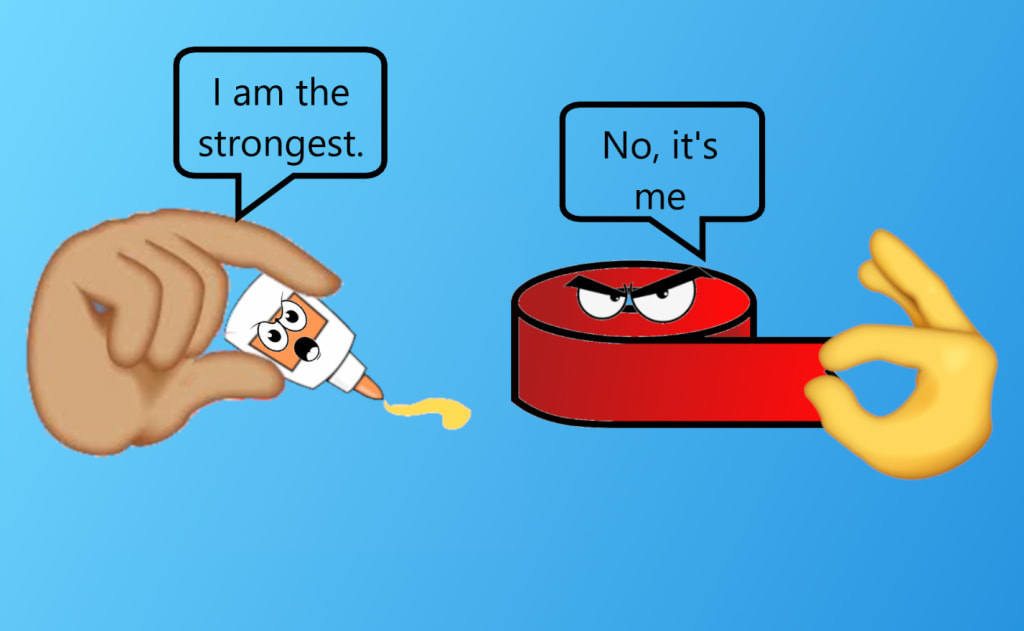
In the annals of human history, perhaps no other substance has played as pivotal a role in our civilization's development as glue. Dating back over 8,000 years, the earliest known adhesive emerged from a cave near the Dead Sea, crafted from a blend of animal bone and plant materials. This ancient concoction served to waterproof baskets and fashion utensils, epitomizing the ingenuity of early societies in utilizing nature's resources to bind their world together.
Over millennia, the evolution of adhesives has been profound, with modern innovations offering an expansive array of options to build and mend virtually anything. But what lies beneath their remarkable stickiness, and is there a clear victor between glue and tape in the contest of strength?
Adhesives, whether derived from synthetic molecules or natural sources like vegetable starch and tree resin, rely on a delicate interplay of adhesive and cohesive bonds. Adhesive bonds form between the molecules of the adhesive and the surface it adheres to, while cohesive bonds keep the adhesive itself intact. Most glues comprise adhesive polymers suspended in a solvent, with the latter preventing premature sticking and often lending the distinctive odor associated with these products.
The drying process of glue, while essential for creating strong bonds, renders them irreversible once set. This characteristic distinguishes glue from tape, which forms weaker, yet reversible bonds upon application. Tape's adhesive properties stem from a combination of rubber-like components and tackifiers, which allow it to adhere to surfaces without the need for chemical reactions. Instead, the adhesive flows into microscopic crevices, exploiting Van der Waals forces to maintain its grip.
But what defines the "strongest" adhesive? The answer eludes a simple proclamation, as different adhesives excel under diverse circumstances. Cyanoacrylates, commonly known as super glues, boast formidable bond strength, while two-component epoxy glues offer superior resistance to heat and shearing forces, making them ideal for demanding applications.
Consider the scenario of suspending an anvil in mid-air: super glue may suffice, but facing the fiery depths of an active volcano, epoxy emerges as the safer choice. Yet, adhesive strength is only part of the equation. Duct tape, though lacking in sheer adhesive power compared to epoxies, compensates with its versatility and instant adhesion, making it indispensable in emergencies or unconventional situations.
Engineers, tasked with critical decisions in fields ranging from aerospace to automotive, navigate a complex landscape of adhesive properties, weighing factors such as temperature resistance, surface compatibility, and application ease. In the quest for optimal performance, the choice between glue and tape becomes a strategic consideration, with each offering distinct advantages in specific contexts.
Even beyond the confines of Earth, adhesives play a vital role in extraterrestrial endeavors. While traditional liquid glues falter in zero gravity, duct tape remains a steadfast companion, capable of bridging gaps and effecting repairs in the vacuum of space.
In essence, the enduring saga of glue and tape embodies humanity's quest for connection and innovation. From the humble origins of ancient adhesives to the cutting-edge formulations of the present day, these substances continue to bind us together, both figuratively and literally, in the grand tapestry of human achievement.
However, the story of adhesives extends beyond their practical applications. It delves into the realm of materials science, exploring the intricate chemistry and physics behind their adhesive properties. Adhesives operate on a molecular level, with adhesive bonds forming between the adhesive molecules and the surface they adhere to. These bonds rely on a combination of intermolecular forces, such as hydrogen bonding, dipole-dipole interactions, and Van der Waals forces, to establish a strong connection between the adhesive and the substrate.
Cohesive bonds, on the other hand, occur within the adhesive itself, holding its molecules together. The balance between adhesive and cohesive forces determines the strength and durability of the bond. Too much adhesive strength without sufficient cohesion can result in the adhesive layer separating from itself, leading to failure. Conversely, too much cohesion without adequate adhesive strength may cause the adhesive to remain intact but detach from the substrate.
The composition of adhesives varies widely, with different formulations tailored to specific applications and performance requirements. Synthetic adhesives, such as cyanoacrylates and epoxies, offer precise control over adhesive properties, allowing engineers to design adhesives with tailored characteristics, such as flexibility, temperature resistance, and curing time. Natural adhesives, derived from sources like plants and animals, offer sustainable alternatives with unique properties, such as biodegradability and non-toxicity.
In recent years, advances in materials science and nanotechnology have led to the development of novel adhesive materials with unprecedented properties. Biomimetic adhesives, inspired by natural adhesion mechanisms found in geckos, mussels, and insects, exhibit remarkable adhesive strength and versatility, offering new opportunities for applications in fields such as robotics, aerospace, and medicine.
Moreover, the quest for environmentally friendly adhesives has gained momentum in response to growing concerns over plastic pollution and resource depletion. Researchers are exploring sustainable adhesive alternatives derived from renewable sources, such as plant-based polymers, bio-based resins, and microbial adhesives. These eco-friendly adhesives offer the promise of reducing carbon emissions, minimizing waste, and promoting a circular economy.
In conclusion, the story of adhesives is a testament to human ingenuity and innovation. From ancient glues crafted from natural materials to modern synthetic adhesives engineered with precision, these remarkable substances have played a crucial role in shaping our world. As we continue to push the boundaries of materials science and technology, the quest for stronger, more versatile, and sustainable adhesives will undoubtedly remain a driving force behind future innovations.
About the Creator
ava
The future belongs to those who prepare for it today






Comments
There are no comments for this story
Be the first to respond and start the conversation.